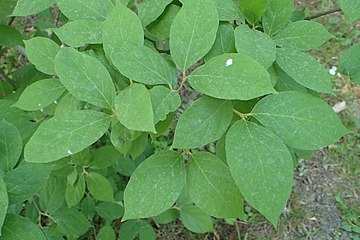|
Calycanthus floridus
Calycanthus floridus, or commonly known as the eastern sweetshrub, Carolina all spice, or spicebush,[3] is a species of flowering shrub in the family Calycanthaceae.[4] It is identifiable by its dark red flowers and fragrant scent. It is non-invasive and is found in the Southeastern United States region. The Nature Conservancy considers its conservation status to be G5, globally secure, indicating it is at low risk of extinction.[1] It is presumed to have been extirpated from Ohio.[1] DescriptionCalycanthus floridus is a shrub that grows to be around 6 to 9 ft (2 to 3 m) tall.[5] Its leaves are a dark green with a pale underside. They are ovate or elliptical in shape and grow to be about 6 inches (15 cm) in length.[5] The leaves are simple, entire, and arranged oppositely along the stem.[6] The flowers are solitary, featuring a reddish brown to reddish purple color when they bloom in spring. They are aromatic and so are the leaves when bruised.[5] The flowers have a hypanthium that is more than 2 cm (0.8 in) long.[7] The shape of the flowers can be cylindrical, ellipsoid, pyriform, or globose.[8] The flowers have numerous tepals that can either be oblong-elliptic or obovate-lanceolate at maturity.[8] The flowers are perfect, having both stamens and carpels on the flowers. The stamens are numerous, connective beyond the anthers.[7] The carpels are numerous. They are free, with a single ovary in a locule.[7] The fruits are indehiscent pseudocarps that are about 8 cm (3 in) in length and 5 cm (2 in) in diameter at maturity.[7] They are formed within the receptacle and contain numerous achenes that are roughly 10 mm (0.4 in) long with a 5 mm (0.2 in) diameter.
Taxonomy Calycanthus floridus was first scientifically described by Carl Linnaeus in 1759.[2] It was the only species in his new genus Calycanthus. Linnaeus referred to an earlier illustration by Mark Catesby,[9] contained in a work published from 1731 onwards. Plants of the World Online accepted two infraspecies:[10]
Distribution and habitatCalycanthus floridus is native to the eastern United States.[11] It prefers sunny habitats but can tolerate moderate amounts of shade. It grows well in environments that feature moist substrate.[12] UsesIt is used in horticulture as the flowers are showy and fragrant.[12] The bark of the plant is edible and is reportedly used as a substitute for cinnamon. The petals of the flower are also reportedly used in medicinal tea-making. Strong caution is advised however, as an alkaloid in the plant may lead to heart convulsions. The viscous substance within the plant is reportedly used as a disinfectant.[13] It is highly resistant to diseases and insects, although it is prone to infection by Agrobacterium tumefaciens, which leads to the formation of crown galls on the stems.[11][14] This plant has been marked as a pollinator plant, supporting and attracting beetles.[15] References
External links
|
||||||||||||||||||||||||||||||||||||||||||





